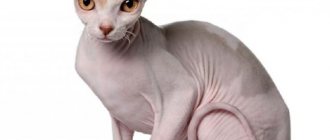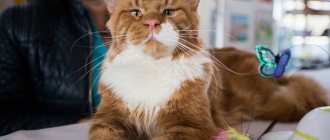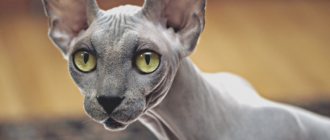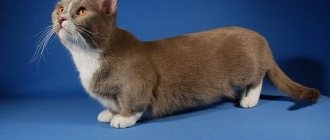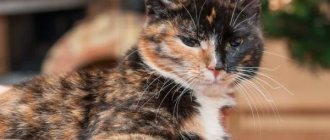8806Administration
This breed is one of the most ancient among those existing on earth and has a rich history. Breeding these animals for profit began relatively recently. Mating of Sphynxes is no different from that which is carried out with other cat breeds. But to obtain purebred offspring, this issue should be approached as seriously as possible. There are only three types of sphinxes: St. Petersburg, Don and Canadian.
All these species are rightfully considered exhibition species, therefore they are in considerable demand both among animal lovers and among professional felinologists.
Sphynxes are also bred because they are in great demand among allergy sufferers. Animal health is subject to full checks. Mating of the Don Sphynx can be carried out only after the onset of the cat's third heat . A more successful date will take place on the third or fourth day of the cycle, when the desire to procreate will be stronger than the rest.
Note. When collecting a history of a potential partner, special attention is paid to the presence or absence of any deviations regarding the standards inherent in this species. Before breeding Sphynxes, it would be a good idea to check the past litters of the chosen partner to determine his ability to convey his own qualities and characteristics.
© shutterstock
Often no outside help is required. But it is also worth taking into account the natural curiosity of this species and their innate friendliness, which can delay the process for some time. Such a feature as the absence of wool requires a complete absence of drafts in a warm room. You should also take care of the manicure of both animals, as they can significantly harm each other.
If the date was successful, then after 64 days the owners can get cute cats. If not, then the next mating is scheduled.
Traits that are inherited
Covers and color
In order to obtain the desired characteristics in the offspring, you must first understand the distinctive features of purebred cats. The colorful colors of the offspring are caused by the carriage of the color gene or the parent has a multi-colored color, which indicates the dominant expression of the gene. According to the condition of the integument, they are distinguished:
- hunger-born;
- velor (flock) - wool in its infancy;
- “brushes” - the kittens’ skin is dotted with rings; as they grow, the cat “goes bald.”
Naked cats cannot be mated with the same species. This is fraught with genetic diseases of the offspring or stillbirths.
Exterior
There are three types of the Sphynx breed, which differ in appearance and some habits.
There are 3 officially accepted breed types:
- The Canadian Sphynx is the oldest. Islands of hair, developed torso muscles, a wide chest, round and slanted eyes, and no mustache are acceptable on the paws, tail and head.
- Petersburg species - the breed was obtained from crossing a Siamese cat and a Don Sphynx. Elongated torso; wide ears turned to the sides; flat cheekbones; narrow, deep-set eyes.
- Don Sphynxes can be easily identified by their absolutely hairless coat, huge ears and many folds on the body. They do not mark territory, have an increased appetite to ensure high heat transfer, are easy to train, and do not have eyelashes.
Puberty
It occurs much earlier than the physiological one - at 6-8 months. In males this happens later. It is recommended to start mating with a cat from the 3rd heat. The time of puberty and hormonal storms is marked by changes in the behavior and character of both sexes. The cat becomes affectionate, pliable or sharply aggressive, unapproachable. He attracts attention in different ways, rubs against objects, walks slowly and purrs, trembles, and moves his paws. The male begins to show belligerence, becomes demanding, and leaves marks.
Health of the Canadian Sphynxes
The health of sphinxes cannot be called strong, but with proper care, their average life expectancy is from 13 to 18 years. Representatives of this breed are characterized by the following diseases.
Dermatitis
Inflammation of the skin, which may be accompanied by itching, ulcers, pimples, runny nose and watery eyes. The reason may be:
- hormonal imbalances;
- immune disorders;
- bacterial or fungal infections;
- mites;
- allergy.
Diagnosis may require a blood test in addition to a visual examination. Treatment is prescribed depending on the cause. If the disease was caused by an allergy, its source must be eliminated.
Eczema
Eczema is a skin disease in which the affected areas become inflamed, flaky, or weepy. It happens:
- traumatic. Develops due to damage to the skin: burn, insect bite, etc.;
- neuropathic. May occur due to illness or stress. The affected areas are usually located symmetrically;
- reflex. The skin becomes inflamed due to an external or internal irritant: allergies;
- pollution;
- diseases of the gastrointestinal tract, liver or kidneys;
- feeding errors;
- hormonal imbalances.
Diagnosis includes examination, skin tests, sometimes urine analysis, general and biochemical blood tests. The treatment regimen depends on the underlying cause. In some cases, the disease goes away quickly, but if it arose due to congenital diseases, relapses will recur regularly.
Acne
Acne is usually associated with hormonal surges. It is often observed in young animals at the stage of puberty, females before and after estrus, as well as in breeding males. Predisposition depends on heredity and color. Blue, cream-blue and red individuals are most often affected. The treatment regimen is prescribed by the veterinarian. It is important that an animal suffering from acne is exposed to the sun as little as possible. In particularly difficult cases, castration is necessary.
Sphynx cats, like humans, can suffer from acne due to hormonal surges.
Vasculitis
Vasculitis is inflammation of the walls of blood vessels. The cause may be infection, stress, or another skin disease. Drug-induced vasculitis associated with excessive or irrational use of drugs is not uncommon.
Depending on the type, the disease may manifest itself as:
- red or pink spots;
- a mesh or branched pattern on the skin, turning into bluish spots and nodules of subcutaneous hemorrhages;
- spots accompanied by swelling and the appearance of crusts.
Diagnosis includes examination and biochemical blood test. The treatment regimen may include injections or oral medications.
Obesity
Sphynx cats love to eat and are therefore prone to obesity. It is important to control the animal’s body weight, otherwise many body systems will suffer. Excessive weight is considered to be 20-30% above average.
Birth defects
Sphynx dogs may have the following birth defects:
- shortening of the lower jaw;
- abnormal eye development (microphthalmos);
- turning of the eyelids;
- curvature of the tail.
When to start breeding?
It is recommended to carry out the first mating after the first year of life, but do not delay it, as diseases may appear later.
You need to knit a cat for the first time at 1.5-2 years of age.
Diseases and other problems may appear later. Early matings will lead to inferior offspring. Often bringing animals together for mating is not recommended. This exhausts both organisms. It is optimal to produce litters 3 times within 2 years. Before the mating period, you can have “dates” for preliminary acquaintance. Estrus on the 3rd day is most favorable for conception. But it may not happen immediately, so the partners are left together for 2-3 days.
How to choose a cat for breeding?
When choosing a partner, it would be useful to examine the offspring that have already appeared from him to determine whether the kittens have the transmitted qualities and characteristics of the breed.
The cat must meet all the requirements for it, according to the breed standard. Animals are required to be checked for sexually transmitted diseases. Usually, all the conditions are met by specimens that take part in exhibitions, are evaluated by commission experts, and have all supporting documents. You can pick up a pair in a nursery, a cat lovers club, at exhibitions, or privately. Nurseries provide mating services with purebred cats, providing guarantees for the production of healthy offspring. The employees provide good care, food, and veterinary care, so marriage is practically excluded here. Sphynxes purchased as a pet and not for breeding are not bred. The litter in this case will be outbred.
History of the Canadian Sphynxes
The history of the breed began in 1966, when a hairless kitten named Prune was born in the Canadian city of Toronto. After some time, the baby and his mother were acquired by the breeder Jania Bava, who ran a nursery of Siamese cats: she and her son Ridyad decided to breed a new breed. Later the Tenhove couple joined the work.
When Prune grew up, he was mated with his mother. Their offspring included both regular and hairless kittens. In the hope of strengthening the trait, breeders began to breed Prun with his daughters and granddaughters, but things went slowly: there was too little breeding material, and hairless kittens often died. In 1971, the CFA revoked the provisional status granted to the breed the previous year. The breeders curtailed their work and sold some of the animals.
In 1973, David Mair from San Francisco bought a cat named Epidermis from them. The man became interested in hairless cats and did a lot to popularize them. In addition to Epidermis, he acquired another bald male and a female. None of his pets left offspring. Two more animals - a male and a female - were purchased from the Bava couple by the Mewsi-Kal nursery, owned by Sandy Kaiser. This couple gave birth to kittens - a boy, Starsky, and a girl, Johnny. In 1978 they were sent to the Netherlands to breeder Hugo Hernandez. However, a problem arose: the litter born from a single mating of animals died because the mother abandoned it.
In 1978, in Toronto, a woman named Shirley Smith rescued two stray kittens abandoned by their mother: a hairless boy named Bambi and a long-haired girl.
Bambi was injured, including a bloody eye and damaged testicles, which required him to be castrated. Nevertheless, the baby was released, and he happily lived for another 19 years in the Aztec nursery. The touching story of this rescue contributed greatly to the popularization of the breed.
A year later, Bambi's mother brought another litter, which included two hairless girls. This cat is considered one of Prune’s undocumented descendants, especially since it happened relatively close to the first cattery.
The girls were sent to Holland to Hugo Hernandez and entered into a breeding program under the names Punky and Paloma. However, Starsky showed no interest in any of them, and in 1981 he was neutered and declared unfit for breeding. Only after this it was discovered that Paloma, who by that time had been given to breeder Nanny Nathan, was pregnant by him. Unfortunately, the cat did not bear offspring.
Since there were no more males available, Punky was bred to a Devon Rex named Kerer van Jetrophin. After this, a litter of hairless kittens was finally born safely. Subsequently, Devon Rex were regularly used to replenish the gene pool.
The “Canadians” inherited their characteristic ears from the Devon Rex.
In parallel, a second line of sphinxes arose. In 1975, in Minnesota, an American Shorthair cat owned by the Persons gave birth to several hairless kittens in different litters. According to different versions, she could be a descendant of Prune or receive the baldness gene due to a random mutation.
In 1981, two hairless cats that belonged to the Persons were purchased by the Stardust cattery. His owner Kim Muesk initially tried to use American Shorthair cats for breeding, but failed. Then Solveig Pfluedger - chair of the genetics department at TICA - advised her to use Devon Rex cats, and the offspring were successful.
In 1985, TICA recognized the breed. A year later, the cat Lady Godiva, born in the Britanya cattery, received the title Supreme Grand Champion. The CFA recognized the breed in 1998 and created a Champion class for it in 2002.
Currently, hairless kittens sometimes continue to be born due to mutations in cats of various breeds. Nurseries are trying to purchase them for a fresh infusion of blood. At the moment, the breed is recognized by all international felinological organizations.
Preparation
To get healthy offspring, it is important to follow all procedures, which include vaccinating the animal and taking tests.
Getting healthy offspring is a responsible matter. It requires time and effort from the owner. The unusual nature of the breed is an additional factor influencing the seriousness of the approach. Preparatory activities include:
- Vaccination of the animal according to the calendar, deworming, testing to confirm health. Mating no earlier than 2 weeks after the last vaccination.
- If your pet is receiving hormones to suppress sexual desire, they must be discontinued in advance.
- Searching for a partner in advance.
- Hygienic conditions - trim nails to avoid injury and avoid bathing before mating to preserve natural scents.
- The lack of thick fur in sphinxes makes it necessary to take care of a warm room without drafts (especially important for Don sphinxes).
Care and maintenance
Caring for the Canadian Sphynx has several features. The lack of fur is a factor in the fact that these cats require special care than other cats. Skin secretion, that is, the sweat and sebaceous glands of sphinxes work like those of an ordinary cat. A coating forms on the surface of the skin, which leaves characteristic grease stains on a person’s clothing and furniture upholstery, especially white ones.
To avoid this behavior, it is necessary to regularly carry out hygiene procedures. Some people believe that wiping their pet with wet wipes is enough. However, the optimal solution is water procedures performed once a week. To do this, you can choose special shampoos or replace it with children's shampoo. After bathing the sphinx, it is necessary to wrap it well in a towel so that the animal does not become overcooled or frozen.
The issue of hypothermia is a special issue for all hairless breeds. When a person holds her in his hands, she seems very hot to him. Due to their fur, heat exchange in these animals occurs more intensely than in ordinary cats.
Canadian Sphynxes.
In a cool room or outdoors, they will freeze faster than their furry counterparts. Many owners buy clothes for their pets that will help them survive the off-season or autumn period, when heating is not yet available in city apartments.
Otherwise, caring for the animal is the same as for other cats. It is necessary to periodically examine the eyes and ears and remove any accumulated dirt there. If the animal receives soft food, it is necessary to brush its teeth with animal pastes. Such compositions effectively remove plaque and tartar and prevent caries. The cat must have the following items:
- tray;
- care products (for bathing);
- dedicated sleeping area;
- two bowls;
- toys;
- cat corner;
- carrying
In addition, the animal must have a comfortable scratching post, otherwise furniture, wallpaper, and wooden furnishings will suffer.
Features of the mating process
As a rule, mating of sphinxes does not require outside intervention. But it is better for the owners to be nearby, controlling the process. Natural friendliness and curiosity can lengthen a date. To avoid troubles, it is advisable to pair a Sphynx cat with a cat who already has sexual experience and conduct the mating on his territory. The female will be helped in a strange home by her own objects - a tray, food, basket or house. During estrus, by her appearance and behavior, the cat asks the cat for intercourse. Sometimes, on the contrary, in an unfamiliar environment, she “forgets” why she came. It happens that the female is brought before the time when she is ready to conceive. The male quickly assesses the situation. With his indifference and indifferent behavior, he shows that he does not want a cat. With a positive turn of events, sphinxes emit loud cries. After mating, the cat will begin to lick itself, and the cat will roll out on the floor.



